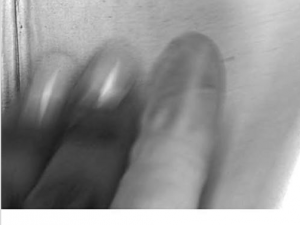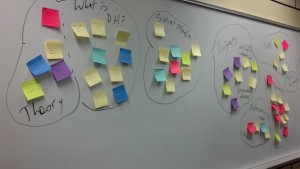(Apologies if the French translation is off–I don’t speak it and am relying on a machine translation (and I’m sure Julia can tell us why that’s a bad idea!))
Since my interests lie more heavily in the still-copyrighted 20th century, I turned to my other love of Arthurian legends for this task. Specifically, I looked at the seminal collection of French (and one Middle English) tales written into English as Le Morte D’Arthur by Sir Thomas Malory, which was available in all 4 digital libraries. I chose to focus on Volume 1 to narrow down the information and compare the resources.
Project Gutenberg offered the second-greatest number of formats (HTML, EPUB, Kindle, Plucker, QiOO Mobile, and Plain Text UTF-8), but for only one edition of the book which is not clearly identified. It says the editor is William Caxton, who produced an edition in 1485 that has become the basis for most of the editions of the book (the other being the Winchester Manuscript), and contains his Preface, but it also contains a Bibliographic note by A. W. Pollard without identifying him as the editor. Nor does it contain a publisher or print date beyond the release date of November 2009. It also lacks any information as to which specific source was the basic for their digitization. In terms of page layout, the EPUB and Kindle editions specify that there are no images, but whether that has an impact is unclear with out a specified edition. A big frustration when reading online is the lack of page numbers to correspond with the chapter listings in the table of contents, if not hypertext links from the table of contents to those chapters, making it hard to move through the book unless you know the specific page to jump to. Although there is no specific place on the book page to report errors, the top of the screen does have an “ad” reading: “Did you know that you can help us produce ebooks by proof-reading just one page a day? Go to: Distributed Proofreaders“. This suggests that they are crowdsourcing their quality assurance process. The online reader seems to be restricted to viewing only; however, you can download copies of the books to give you the affordances of the other formats (such as Kindle).
Google Books hosts several editions of Le Morte D’Arthur. One is the Everyman Library edition, also based on the Caxton text, edited by Ernest Rhys and published by J.M. Dent in 1906. It was sourced from the University of Michigan and is available as an EPUB and a PDF in addition to online viewing. This edition includes the rather beautifully illustrated title pages; however, one has to scroll past multiple scans of the University of Michigan title plate, blank pages, and this interesting failure in scanning to find it:

It also preserves Caxton’s original preface. Google Books also hosts another version of Caxton’s text published by bompacrazy.com, which appears to be a scan of a PDF and is just plain text. There’s also an edition by digireads.com ebook for purchase. Other than reviews, there does not seem to be a system for reporting errors (otherwise, I’d assume someone would have already have cut out the excess pages). Google Books allows you to download, search within, and save a copy to “My Library”; however, it does not allow you to annotate the book.
HATHITrust also has the Rhys editions, but scanned by Google from the University of Cornell and University of Virginia in addition to the University of Michigan. In addition, it has two other 19th century editions: an 1891 Macmillan publication with the Caxton text edited and introduced by Edward Strachey from the Universities of Michigan and Toronto, digitized by Google; and an 1889 Nutt publication in which Caxton’s text is “‘reprinted page for page, line for line’, but in modern type”, edited by Oskar Sommer and introduced by Andrew Lang, from the University of California, digitized by Google. Each of the editions is only available in PDF format, and for some reason, both Rhys editions are for volume 2, rather than one of each. Although HATHITrust offers the most viewing options (Classic View, Scroll, Flip, Thumbnails, and Plain Text), the Flip presentation of a book spine and cover are clearly a graphical representation instead of a realistic one. (I will say that it’s fun to run your cursor over the “pages” and watch the “jump to page __” numbers flip rapidly. For some reason this strikes me as similar to riffling the pages of a real book.) Page layouts are preserved, including italics, spacing, and footnotes. HATHITrust offers a Feedback form if there are any problems with the text, as well as the ability to search, download single pages or the whole document, add the book to a collection (if one has University access to sign in!), or share it with others. HATHITrust offers a few full text versions, but many were only limited to viewing or to “snippets” of the full text.
The Internet Archive offers the greatest number of formats, with each edition available for download in PDF, EPUB, Kindle, Daisy, Full Text, and DjVu. It contains the Rhys edition from the University of Michigan as digitized by Google, but also from the University of Toronto and the New York Public Library; the Strachey edition from Stanford Library and the University of California; and the Sommer edition from the Universities of Toronto, Michigan, and Cornell University. The Internet Archive presents the book as if one were looking at a paper version, with page turns instead of scrolling, in a slightly more realistic way than HATHITrust (and offers the same satisfaction in riffling the pages). Also, for the Strachey version, it looked as if many of the actual page images were presented instead of just the scanned text; I could clearly see that the bibliographic page in the Stanford book was torn and repaired with tape. Some pages are badly scanned, with the margins of text cut off or wavy. However, the marginalia from users has been preserved.

Yet more fingers.
The Internet Archive offers an editable web page on Open Library that seems like the method for users to make changes (such as adding new editions), but I’m not sure if it also acts as an official reporting system for errors. It allows users to search, bookmark, write reviews, share the book, and have a computer read the text aloud. Interestingly, when I asked the computer to read aloud, it was forced to spell out “Rhys” rather than pronounce it, but had no trouble pronouncing the words “Igraine” or “pyonce”. There do not seem to be any restrictions on use, and the site offers “selected metadata” that might be useful for creating databases for further study.
I tested the search features in each library by searching the book for the word “swoon” (since the amount of swooning, primarily among the supposedly noble and heroic knights of the Round Table, surprised me the most when I read the book). Google Books shows 14 results in the book with hyperlinks to the individual pages and excerpts from the text to show the context of the word. HATHITrust showed the word on 13 pages for a total of 15 results, also with hypertext linking and excerpts to show context, although the excerpts were shorter than those in Google Books. Surprisingly, the Internet Archive produced no results; it did manage to find character names when asked, and provided a popup window of context with links to the individual word searched. The Kindle download from Project Gutenberg found 25 results, displayed in a sidebar which shows the context and the location, which can be clicked on; however, the search term is not highlighted on the page when it is brought up, and so can still take a bit long to find.
One of the biggest challenges in examining Le Morte D’Arthur was that the different editions were labelled inconsistently in the catalogs. For example, some editions claimed to have Janet Cowen as the editor, and when opened, turned out to be the Strachey edition. Still others were not clearly labeled as to which volume it was. Most concerning is the lack of any particular identifying information about the Project Gutenberg text. Clearly, digital libraries need to establish the same criteria as print libraries for making sure their catalog databases are precise and accurate.







